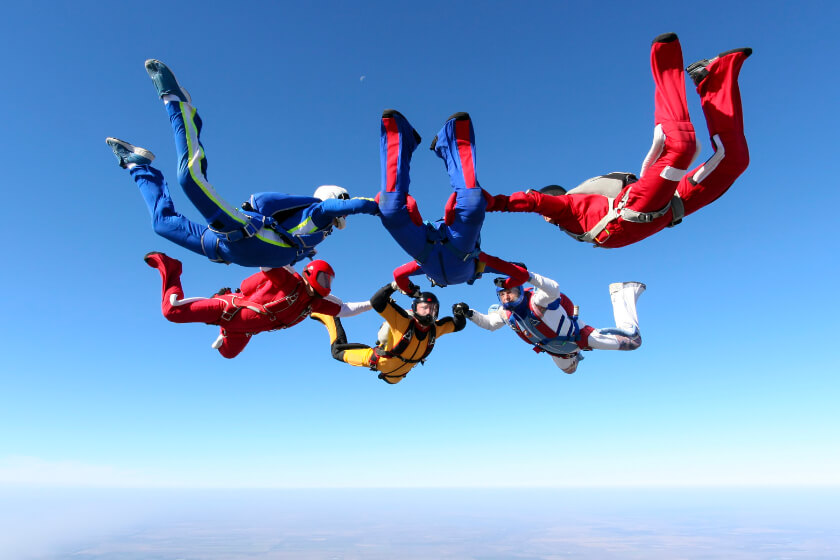
Most Dangerous Sports

Playing sports is fun and good for you. Engaging in physical activity helps build muscles and strengthens your heart, for example, and the exercise improves your mood, boosts energy, and helps you sleep better. Sometimes sports can be dangerous, though, and cause injury or even death.
4 Deadly and Dangerous Sports
BASE jumping
BASE jumping is the deadliest extreme sport in the world. The acronym BASE stands for the four fixed objects from which a BASE jumper can jump: buildings, antenna (radio masts), spans (bridges), and earth (cliffs). BASE jumping is more dangerous than parachuting because the fixed objects are much lower to the ground, which means there is less time for the parachute to open. In a 2007 study, researchers reviewed 20,850 jumps occurring over 11 years; 9 of these jumps were fatal and 82 were non-fatal. BASE jumping is even more dangerous for those wearing wing suits to extend their flight time.
Non-fatal injuries associated with BASE jumping include ankle sprains/fractures, minor head concussions, and bruised knees.
Swimming
Swimming is the deadliest non-extreme sport, claiming an average of 11 lives in the United States every day, according to the CDC. There is an average of 22 non-fatal drownings each day. Swimming can also cause neck injuries, “swimmer’s shoulder,” and “swimmer’s knee.”
Bicycling
Nearly 1,000 cyclists die each year, according to the CDC, and more than 130,000 sustain injuries. Adults ages 55 to 69 have the highest rates of death, but adolescents, teens, and young adults have the highest injury rates. Bicycling deaths and injuries often involve collisions with motor vehicles.
The most common bicycling injuries include knee pain, head injuries, neck or back pain, wrist or forearm pain or numbness, and foot numbness and tingling.
Running
Running is a popular – and sometimes dangerous – sport. As with bicycling, running deaths are sometimes due to collisions with motor vehicles, as runners often share the road. Sudden cardiac arrest is the most common cause of death, especially among marathon runners. Still, the risk of death while running a marathon is low: research shows that there is about 1 death per 149,968 marathon participants.
About half of all runners will suffer a non-fatal injury each year. Injuries are sometimes caused by trauma, such as a fall, but most are the result of overuse. Running injuries include runner’s knee, stress fractures, muscle pulls, ankle sprains, and shin splints.
7 Sports Most Likely to Cause Injury
Basketball
Basketball causes the most injuries for players of all ages, according to Healthgrades. Doctors treated about 570,000 basketball players in 2012; of these, about 8,000 were hospitalized. Basketball injuries include ankle sprains, jammed fingers, knee injuries, deep thigh bruising, facial cuts, and foot fractures.
Football
Football causes the most injuries of all sports for kids ages 12 to 17. More than 466,000 people in the United States suffered a football injury in 2012; of these, 10,000 were hospitalized for their injuries. Injuries commonly associated with football include ankle sprains, knee injuries, and quadricep, hamstring, and groin strains.
Soccer
Soccer injuries send more than 231,000 people to the emergency department each year. Common soccer injuries include ankle sprains, knee sprains, calf strains, and fractures of the clavicle, feet, or wrist.
Ice hockey
Ice hockey causes the most concussions. Of the 3 million teens who play ice hockey in the United States, nearly 10,000 sustain injuries, and 31 percent of these injuries are concussions. Other ice hockey injuries include injuries to the AC joint in the shoulder, ACL strains or tears in the knee, broken collar bones, and muscle strains.
Cheerleading
Many people do not realize that cheerleading is a competitive contact sport that involves gymnastics, forming human pyramids, and throwing teammates into the air – all of which can cause sports injuries. In 2011, cheerleading caused 29,000 injuries. Common cheerleading injuries include concussions, sprains, and strains.
Baseball and softball
While they are not contact sports, baseball and softball are risky. In 2012, emergency departments treated 265,000 people for sports injuries associated with baseball or softball – 4,500 of these patients were admitted to the hospital. Injuries include torn labrum and rotator cuff injuries of the shoulder, shoulder instability, and tendonitis or other injuries of the wrist.
Diagnosis of Sports Injuries
An accurate diagnosis of sports injuries is essential for treatment. Doctors assess and diagnose sports injuries by examining the injured area. In many cases, doctors order imaging, such as x-rays, ultrasound, and MRIs. They may order a CT scan to get a more detailed look at bones and soft tissue, and to find fracture lines, loose bodies, and other complications within complex joints.
For more information on the most dangerous sports, consult with a trainer, doctor, or radiology professional. Early and accurate diagnosis, along with prompt treatment, can help you get back on the playing field quickly.




